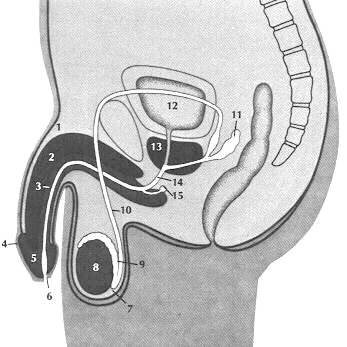|
|
||||||||
|
|
2.1.1 THE EXTERNAL SEX ORGANS
1. Penis 2. Corpus cavernosum (one of a pair) 3. Corpus spongiosum 4. Foreskin 5. Glans 6. Opening or urethra 7. Scrotum 8. Testicle (one of a pair) 9. Epididymis(one of a pair) 10. Vas deferens (one of a pair) 11. Seminal vesicle (one of a pair) 12. Urinary bladder 13. Prostate gland 14. Urethra 15. Bulbourethral (Cowper's) gland (one of a pair) During an erection the penis increases in size. This is possible because the skin covering it is very loose. In fact, toward the end of the penis some of this skin forms a freely hanging fold known as the foreskin or prepuce. This foreskin normally covers the tip or head of the penis called the glans. In the case of an erection, however, the glans protrudes from the foreskin and becomes fully exposed. The glans is usually slightly thicker than the body of the penis, and its shape has been compared to that of an acorn. (Glans is Latin for acorn.) Actually it is the extension of the corpus spongiosum, and it contains the external opening of the urethra. Since its smooth surface is studded with innumerable nerve endings, the glans is extremely sensitive to the touch, particularly around its rim. By the same token it.is also an important source of sexual pleasure for the male. The underside of the glans is attached to the foreskin by a thin tissue called frenum. Behind the rim of the glans and under the foreskin there are glands that secrete a cheese-like substance known as smegma. If the foreskin is tight this smegma may accumulate and cause irritation. In any case, good personal hygiene demands daily washing of the glans and removal of the smegma. For this the foreskin has to be pulled back. Tightness of foreskin (also called phimosis) is one ot the reasons of a popular operation called circumcision. It consists ot the surgical remuval of the foreskin. This practice has a long tradition among Jews and Moslems, for whom it also has a religious significance. However, in the meantime circumcision has found wide general acceptance, and in the United States today most males are circumcised as a matter of course right after birth regardless of their religion. Circumcision has no effect on a man's sexual abilities. The average length of a grown man's penis is between 3 and 4 inches when flaccid and between 5 and 7 inches when erect. However, there may be great variations in size from one individual to the next. Contrary to some widely accepted myths, the size of the penis is not related to a man's body build, skin color, or sexual prowess. A very short man may have a larger penis than a tall one (and vice versa), a white man may have a larger penis than a black man (and vice versa), and a man with a small penis may have more orgasms than a man with a large penis (and vice versa). Furthermore, some penises which greatly differ in size when they are flaccid may be of identical size when they are erect. For reasons that are not entirely clear, many men in out culture seem concerned about the size of their penises. However, such concern is completely unwarranted. Even a penis that remains relatively small during an erection serves every function of a larger penis. A woman's vagina, for instance, adjusts to any penis, no matter what its size, and since the vaginal walls contain few nerve endings, any difference in the woman's sensations depends on the firmness of her muscles surrounding the vaginal barrel as wel! as psychological factors. (For details, see "The Female Sexual Response.") The latter is also true for sensations inside the rectum during anal intercourse. There is practically no feeling at all beyond the anal sphincter muscles. (This, incidentally, is the reason why some people who introduce long and hard objects into their rectum may seriously hurt themselves without realizing it.) The Scrotum The scrotum is a bag or pouch of skin which contains the testicles, and which hangs between the thighs at the base of the penis. The skin of the scrotum is comparatively dark and contains many sweat glands. Inside the scrotum there are two separate compartments, each of which contains one testicle and its spermatic cord which leads upward into the abdominal cavity. Part of this spermatic cord is a thin tube through which the sperm travels - the vas deferens. It is this vas defeferens that is cut in a vasectomy. (for details, see "Contraception".) The spermatic cord also contains blood vessels, nerves, and muscles. In response to certain stimuli, especially cold temperatures, these muscles contract and pull the testicle closer to the abdomen. At the same time, the skin of the scrotum will also contract and appear thick and wrinkled. Ordinarily, however, the scrotum hangs loose, and its skin looks thin and smooth. In a way the scrotum acts like a thermostat, trying to provide an even temperature for the continuous production of sperm which is taking place inside the testicles. This temperature has to be slightly lower than that of the rest of the body. |

